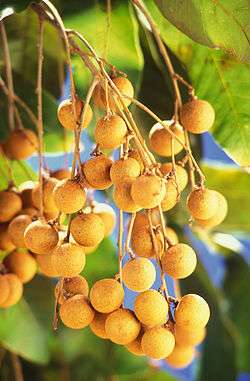Dimocarpus
| Dimocarpus | |
|---|---|
 | |
| Dimocarpus longan fruit | |
| Scientific classification | |
| Kingdom: | Plantae |
| (unranked): | Angiosperms |
| (unranked): | Eudicots |
| (unranked): | Rosids |
| Order: | Sapindales |
| Family: | Sapindaceae |
| Subfamily: | Sapindoideae |
| Genus: | Dimocarpus Lour.[1][2] |
| Species | |
|
see text | |
Dimocarpus is a genus of about 20 species of trees or shrubs known to science, constituting part of the flowering plant family Sapindaceae. They grow naturally in tropical south and Southeast Asia, Malesia, Papuasia and Australasia, including Sri Lanka, India, the Philippines, southern China, Taiwan, Burma, Cambodia, Vietnam, Malaysia, Indonesia, New Guinea, East Timor, far north-eastern Queensland Australia.
The fruit is edible, with the Longan (D. longan) being grown commercially for fruit production.
The species are large evergreen trees growing to 25–40 m tall, with pinnate leaves. The flowers are individually inconspicuous, produced in large panicles. The fruit is an oval drupe 3–5 cm long containing a single seed surrounded by a translucent crisp, juicy layer of fruit pulp and a thin but hard orange or red skin.
Selected species
- Dimocarpus australianus
- Dimocarpus confinis
- Dimocarpus dentatus
- Dimocarpus didyma
- Dimocarpus foveolatus
- Dimocarpus fumatus
- Dimocarpus gardneri
- Dimocarpus longan, Longan
- Dimocarpus yunnanensis
References
- ↑ Leenhouts, Pieter W. (1994). "Dimocarpus Lour.". In Adema, F.; Leenhouts, P. W.; van Welzen, P. C. Sapindaceae. Flora Malesiana (Digitised, online). Series I, Spermatophyta : Flowering Plants. Vol. 11. Leiden, The Netherlands: Rijksherbarium / Hortus Botanicus, Leiden University. pp. 511–519. ISBN 90-71236-21-8. Retrieved 5 Dec 2013.
- ↑ "Dimocarpus Lour.". Germplasm Resources Information Network. United States Department of Agriculture. 2006-03-29. Retrieved 2010-01-19.
Further reading
- Bean, A. R. (March 2005). "The Taxonomic status of Dimocarpus leichhardtii (Benth.) S.T.Reynolds" (PDF). Australasian Systematic Botany Society Newsletter. Australasian Systematic Botany Society Inc. 122 (March): 7. ISSN 1034-1218. Retrieved 15 Dec 2013.
| Wikimedia Commons has media related to Dimocarpus. |